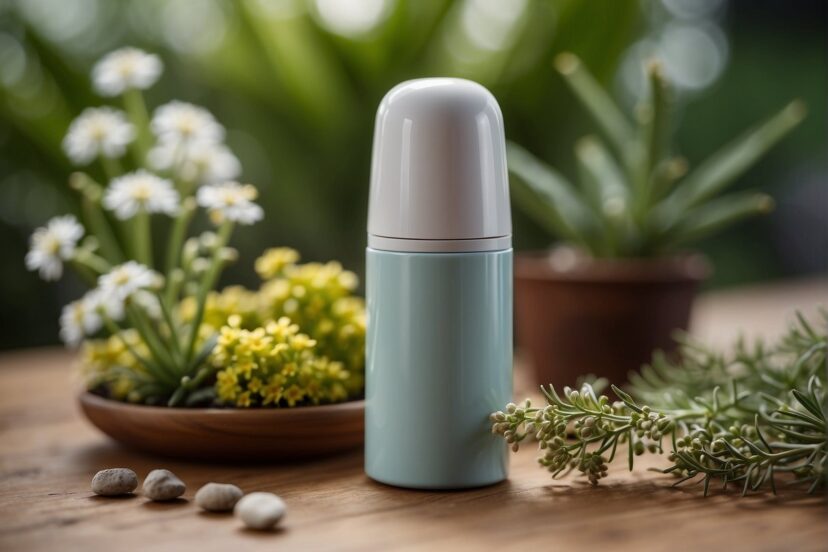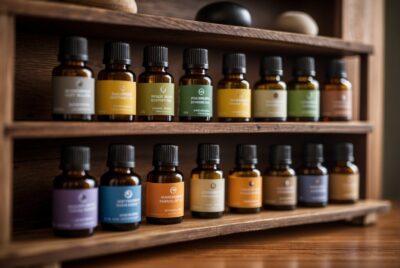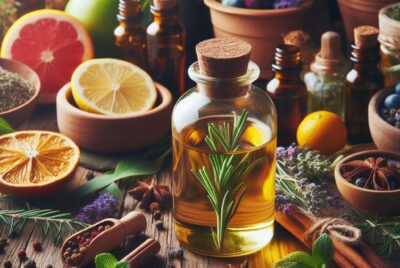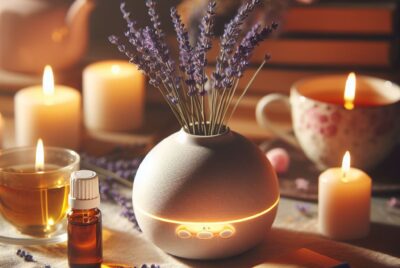Essential Oil Inhaler Benefits: Optimize Your Experience
*We may earn a commission for purchases made using our links. Please see our disclosure to learn more.
Essential Oil Inhaler Benefits: Optimize Your Aromatherapy Experience
An essential oil inhaler is a device that allows the user to experience the benefits of aromatherapy on the go. The portable nature of these inhalers makes them a convenient choice for those seeking to harness the therapeutic properties of essential oils without needing a diffuser or topical application. Inhalers are typically small, easily fitting into a pocket or purse, which means I can enjoy aromatherapy anywhere—from the office to public transport or while traveling.

I find that using an essential oil inhaler involves a personal, intimate approach to aromatherapy as it allows for the direct inhalation of essential oil vapors. This method of use can be particularly effective for managing stress, addressing headaches, or providing support for respiratory concerns. The inhalers usually comprise a tube with a cotton wick inside that absorbs the oils, ensuring that the scent is contained until I’m ready to use it.
As with any form of aromatherapy, the choice of essential oils in an inhaler is crucial. Each oil has its own potential benefits and combining them can enhance the experience. For example, peppermint oil is often appreciated for its invigorating properties, which can be helpful when I need a midday pick-me-up. Meanwhile, lavender can be a go-to for moments when I need to relax or manage tension. I always ensure to select high-quality essential oils and use them responsibly to get the most from my inhaler.
Understanding Essential Oil Inhalers

In this section, I’ll outline the specific components that make up essential oil inhalers and discuss the different types available on the market. I’ll provide detailed insights into how these inhalers are assembled and the variations you might encounter.
Components and Assembly
Essential oil inhalers consist of a few basic parts that are easy to assemble. Here’s a quick breakdown:
- Cotton Wick: This is where the essential oil is applied. It absorbs and holds the oil.
- Inhaler Tube: A cylindrical container that houses the cotton wick.
- Cap: This piece snaps or screws onto the inhaler tube to secure the cotton wick inside.
- Cover: Protects the inhaler and prevents evaporation when not in use.
When assembling an inhaler, I start by adding a few drops of my preferred essential oil onto the cotton wick using tweezers to handle it, ensuring that it’s saturated but not dripping. Next, I insert the wick into the inhaler tube and securely fasten the cap. The cover is then placed over the entire assembly to maintain the integrity of the oils.
Types of Inhalers
The market offers different types of essential oil inhalers, two of which are commonly known:
- Plastic Inhaler: Often the most affordable and widely available, these are made from plastic. They are a popular choice for a personal inhaler due to their lightweight and portable nature.
- Personal Inhaler Variations: Some inhalers come with labels to identify the oil inside or color-coded covers to distinguish between multiple inhalers. They might also feature different designs or materials like glass or metal for aesthetic or durability purposes.
In choosing an inhaler, it’s important to consider personal needs like portability, frequency of use, and preference for sustainable materials. Whether it’s a simple plastic inhaler or a more durable variant, the function remains to provide a convenient way to experience the benefits of essential oils throughout the day.
Benefits of Essential Oil Inhalation
Essential oil inhalation can provide a range of health advantages, uniquely leveraging natural plant extracts to support physical and mental well-being. The following specifics shed light on the particular benefits for physical health, and mental and emotional balance.
Physical Health Benefits
Respiratory Support: I find that inhaling essential oils such as eucalyptus or peppermint opens my breathing passages, offering relief from respiratory issues and sinus headaches. This can be particularly soothing during a cold or allergy season.
- Headache Relief: Essential oils like lavender and peppermint are my go-to for easing headaches, including tension headaches.
Immune System: Some essential oils contain antimicrobial properties, which I believe aid in boosting my immune response.
- Nausea and Upset Stomach: Whenever I experience nausea or an upset stomach, scents like ginger or spearmint inhaled through essential oil inhalers help alleviate my discomfort.
Blood Pressure: Certain essential oils, such as clary sage, have been associated with promoting a sense of calm which may assist in managing high blood pressure.
Mental and Emotional Well-being
Stress Relief: The simple act of taking a deep breath of lavender or chamomile scents helps me reduce stress and anxiety levels effectively.
- Energy Boost: When my energy wanes, I inhale citrus-based oils for an invigorating energy boost that helps rejuvenate my mind and body.
Improved Focus: I’ve noticed when I need to concentrate, scents like rosemary aid in enhancing my focus, making it easier for me to stay on track with my tasks.
- Anxiety Alleviation: To manage my anxiety, the use of oils such as frankincense provides a profound sense of grounding and tranquility.
In my experience, consistent inhalation of essential oils contributes positively to my daily self-care routine, offering both preventative and remedial effects.
Selecting and Blending Essential Oils

When creating essential oil inhalers, the right selection and combination of oils can lead to an effective and personalized experience. It’s important to understand the properties of each oil and how to blend them for specific needs.
Choosing Oils for Specific Purposes
When I select essential oils for a specific purpose, I consider both their therapeutic properties and aroma profiles. Here’s a concise overview of common essential oils and their potential uses:
- Lavender Essential Oil: Known for its calming effects; ideal for stress relief and sleep assistance.
- Peppermint Essential Oil: Used to improve focus and energy, and may provide relief from headaches.
- Eucalyptus & Rosemary Essential Oil: Both have decongestant properties, making them useful for respiratory support.
- Lemon & Grapefruit Essential Oil: Citrus oils like these are uplifting and may help to improve mood.
- Bergamot Essential Oil: Often used for its stress-relieving and mood-lifting effects.
- Frankincense Essential Oil: May support immune function and offer a comforting, grounding aroma.
- Tea Tree Oil: Known for its antimicrobial properties, suitable for boosting immunity.
Here are a few individual uses for essential oils based on their key properties:
| Essential Oil | Key Properties |
| Ginger Essential Oil | May help with nausea and digestion |
| Cedarwood | Can promote relaxation, focus, and groundedness |
| Ylang Ylang | Often used for its stress-relieving properties |
| Roman Chamomile | May help in calming and soothing efforts |
| Clary Sage | Known for its mood-enhancing properties |
Creating Personalized Inhaler Blends
Creating personalized inhaler blends allows me to tailor the aromatherapy experience to my specific needs. The process involves a careful balance of top, middle, and base notes to ensure a harmonious scent that also offers the desired therapeutic benefits. Here’s a simple guide for blending:
- Top Notes: These are the first scents to be perceived and include oils like lemon, bergamot, and sweet orange. They are refreshing and uplifting but evaporate quickly.
- Middle Notes: Make up the heart of the blend. Oils such as geranium, rosemary, and cardamom fall into this category and offer a balancing effect.
- Base Notes: They provide depth and longevity to a blend. Vetiver, cedarwood, and frankincense are common base notes with grounding properties.
For inhaler blends, I start with a total of 15-20 drops of essential oil, ensuring not to overwhelm the senses. Here’s an example of a simple, balanced blend for focus and clarity:
- Peppermint (Top Note): 5 drops
- Rosemary (Middle Note): 7 drops
- Frankincense (Base Note): 3 drops
This blend combines the invigorating properties of peppermint, the cognitive support of rosemary, and the grounding effects of frankincense. Remember to always adjust the number of drops according to personal preference and sensitivity.
Practical Tips and Safety

In my experience, using essential oil inhalers effectively requires attention to detail, especially when it comes to practicality and safety. It’s crucial to understand how to use them safely on-the-go and be aware of health considerations.
Using Inhalers On-the-Go
I always find using an aromatherapy inhaler to be incredibly convenient and economical for maintaining my sense of calm and comfort throughout the day. Here are some specific tips for using inhalers while out and about:
- Keep it clean: Regularly wipe the outside of your inhaler with alcohol to prevent contamination.
- Secure the cap: Ensure the cap is firmly in place to avoid leaks and to preserve the oils’ potency.
- Avoid direct sunlight: Store your diffuser in a cool and dark place to protect the essential oils from degrading.
For those wanting to stay energized or needing a quick way to wake up during a busy day, carrying a portable inhaler with an uplifting scent like peppermint can offer a swift boost. Similarly, if you’re struggling with seasonal allergies or motion sickness, having a suitable blend on hand can provide quick relief.
Health Considerations and Precautions
When it comes to health, I’m particularly cautious. Essential oil inhalers can offer therapeutic benefits, but safety must never be compromised. Be mindful of these considerations:
- Medical conditions: Always consult a healthcare provider before using aromatherapy inhalers, especially if you have existing medical conditions.
- Adverse reactions: If you experience any adverse reactions like headaches or respiratory discomfort, discontinue use immediately.
- Carrier oil inclusion: Some recipes might include a carrier oil; make sure it’s properly absorbed in the wick to avoid direct skin contact which could cause irritation.
For an experience encompassing relaxation, happiness, or motivation, the right blend of oils in your diffuser can make a significant difference. However, it’s essential to perform a patch test with diluted oil before fully committing to inhaling a new blend.
Remember, when using wicks, ensure they are fully saturated with the oil blend and avoid touching the saturated part to prevent any potential skin sensitivity. My personal go-to for supplies like wicks and inhalers is often online retailers like Amazon, which offer a wide array of options.
Frequently Asked Questions
In this section, I provide insights into some of the most common inquiries about essential oil inhalers. My aim is to share accurate information based on both my knowledge and relevant findings on their potential benefits and safe usage.
1. How can essential oil inhalers assist with quitting smoking?
Essential oil inhalers can be used as a part of a larger support system to help manage cravings and withdrawal symptoms during the process of quitting smoking. They provide a sensory distraction and can help reduce the urge to smoke by inhaling therapeutic scents instead.
2. What are the potential health benefits of using essential oil inhalers?
The potential health benefits of using essential oil inhalers include alleviating symptoms such as stress, anxiety, and headaches. They may also support respiratory health by offering a sense of relief during congestion and promoting relaxation.
3. How long does a typical essential oil inhaler last?
A typical essential oil inhaler can last between one to three months, depending on the frequency of use and the type of essential oil blend used. It is important to store inhalers properly to maintain their efficacy.
4. What is an aroma inhaler and how does it differ from other inhalation methods?
An aroma inhaler is a personal, handheld device containing a cotton wick infused with essential oils. Unlike diffusers or direct steam inhalation, inhalers provide a more controlled and individualized experience, allowing for discretion and convenience.
5. Which essential oils are recommended for managing anxiety through inhalers?
For managing anxiety through inhalers, essential oils like lavender, chamomile, and frankincense are commonly recommended. These oils are known for their calming properties and may help soothe nervousness and improve mood when inhaled.




